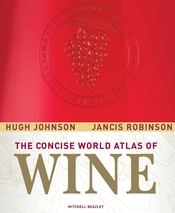The Concise World Atlas of Wine
By Hugh Johnson and Jancis Robinson
Paperback/352 pages/200 full-color maps
Mitchell/Beazley/An imprint of Octopus USA/pub date September 2009
$29.99
Since its first publication in 1971, Hugh Johnson and Jancis Robinson’s comprehensive World Atlas of Wine has been an invaluable source of information for those of us who have a thirst for learning about wine as well as for drinking it. (Disclosure: I am a regular contributor to Mr. Johnson’s annual Pocket Wine Book, also published by Mitchell Beazley). Now in its sixth edition, the authors’ classic guide to the wine regions of the world has been joined by a companion book, the Concise World Atlas of Wine. This smaller, 352 page paperback version is meant to be a more portable version of the original tome, but weighing in at 3 pounds, and measuring 8 by 10 inches, it’s not going to fit easily in your purse let alone your back pocket. But never mind–throw it into the back seat of your car and head off to wine country with it. You’d be hard pressed to find another guide to wines from every corner of the globe that’s as reliable, well organized and engaging as this one. Written by two of the world’s most knowledgeable and erudite wine writers, the book is distinguished by succinct yet friendly prose. It also includes the same detailed, full-color maps that are in the original, although in the smaller format they’ll be useful mainly for wine buffs with either keen close-up vision or superior magnifying eyeglasses.
information for those of us who have a thirst for learning about wine as well as for drinking it. (Disclosure: I am a regular contributor to Mr. Johnson’s annual Pocket Wine Book, also published by Mitchell Beazley). Now in its sixth edition, the authors’ classic guide to the wine regions of the world has been joined by a companion book, the Concise World Atlas of Wine. This smaller, 352 page paperback version is meant to be a more portable version of the original tome, but weighing in at 3 pounds, and measuring 8 by 10 inches, it’s not going to fit easily in your purse let alone your back pocket. But never mind–throw it into the back seat of your car and head off to wine country with it. You’d be hard pressed to find another guide to wines from every corner of the globe that’s as reliable, well organized and engaging as this one. Written by two of the world’s most knowledgeable and erudite wine writers, the book is distinguished by succinct yet friendly prose. It also includes the same detailed, full-color maps that are in the original, although in the smaller format they’ll be useful mainly for wine buffs with either keen close-up vision or superior magnifying eyeglasses.
One of the Concise Atlas’s principle strengths is that, unlike most wine guides, this one frequently offers a point of view in addition to simply stating the facts. Take the description of Loire Valley wines, which the authors describe as “light and invigorating, with palpable acidity. The classic word for them is charming; the classic mystery that they are not more widely appreciated outside northern France. These wines are casualties of the modern wine drinker’s obsession with weight and strength.”
Like fizz in wine, some passages in the atlas sparkle with a stylistic effervescence that makes the densely packed volume of serious information particularly palatable. Indeed, some of the prose is downright literary. Take the introduction to the section on Japan (yes, there is a wine is made there, in 36 of the country’s 43 prefectures): “In constructing Japan, nature seems to have had almost every form of pleasure and enterprise in view except wine,” the authors write. “Although the latitude of Honshju, the main island of the Japanese archipelago, coincides with that of the Mediterranean, its climate does not. Like the eastern USA (lying in the same latitudes), it suffers from having a vast continent to the west. Caught between Asia and the Pacific, the greatest land and sea masses in the world, its predictably extreme climate is peculiar to itself. Winds from Siberia freeze its winters; monsoons from the Pacific and the Sea of Japan drench its springs and summers. At the precise moments when the vines most need sunshine they are lashed by typhoons … It is not surprising, therefore, that Japan has hesitated about wine; hesitated, that is, for about 1,200 years.”
Extracted from the 2008 World Atlas, Concise lacks the photographs from the original tome, but it offers the same information about latitudes, altitudes, temperature variations, grape varieties, appellations, and all the other details pertinent to the world’s wine regions. There is the occasional glitch: for example, I followed instructions to turn to page 235 for information about North America’s French hybrid grapes, but discovered instead a page on the wines of North Africa. And speaking of hybrids, the eastern United States gets short shrift, with far too much precious space wasted on a rehashing of the region’s past history of wines made from hybrid and native grapes, and too little emphasis on today’s tremendous success with vinifera wines. But aside from these minor quibbles this is that rare wine reference book that is overall as well balanced and satisfying as a bottle of Echézeaux. And at $29.99 it’s a lot cheaper than fine Burgundy.
7
